Trump administration renews key leases for potential copper mine next to the BWCA

An exploratory drill site operates 24 hours a day to acquire core samples from thousands of feet below the Earth's surface outside Ely, Minn.
Derek Montgomery for MPR News 2012
Go Deeper.
Create an account or log in to save stories.
Like this?
Thanks for liking this story! We have added it to a list of your favorite stories.


